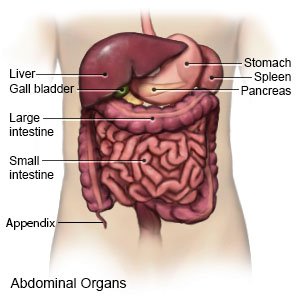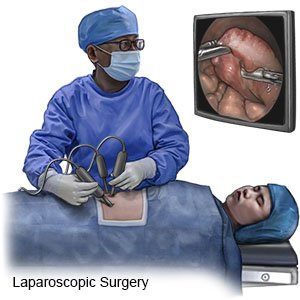Laparoscopic Appendectomy in Children
Medically reviewed by Drugs.com. Last updated on Aug 4, 2025.
AMBULATORY CARE:
What you need to know about a laparoscopic appendectomy:
Laparoscopic appendectomy is surgery to remove your child's appendix. The surgery is done through small incisions in his or her abdomen.
 |
How to prepare your child for surgery:
- Tell your surgeon about all allergies your child has. Tell him or her if your child has ever had an allergic reaction to anesthesia or antibiotics. Antibiotics may be given before surgery to prevent an infection caused by bacteria.
- Your child's surgeon will tell you how to prepare your child for surgery. Tell him or her about all medicines, supplements, and vitamins your child currently takes. He or she will tell you if you need to stop giving any of these before surgery, and when to stop.
- You may be told not to let your child eat or drink anything after midnight on the day of surgery. He or she may need to use an enema the night before surgery. An enema will empty his or her bowel. Your surgeon will tell you if your child needs to do this, and how to do it.
What will happen during surgery:
- Your child will be given general anesthesia to keep him or her asleep and free from pain during surgery. A catheter may be inserted to drain your child's urine. A nasogastric (NG) tube may be inserted through his or her nose and down into the stomach. This tube keeps air and fluid out of the stomach during surgery.
- A small incision will be made in your child's belly button. The surgeon will insert a laparoscope through the incision. This is a flexible tube with a light and camera on the end. Other instruments will be inserted into 1 to 2 smaller incisions in your child's abdomen. The abdomen will then be inflated with a gas. This lifts the abdominal wall away from the internal organs and allows the surgeon more space to work. Your child's appendix will then be removed.

- Drains (thin rubber tubes) may be placed to remove liquid from the incision area. The incisions will be closed with strips of medical tape.
What your child should expect after surgery:
- Your child may feel pain in his or her shoulder or chest from the gas used during surgery. This is normal and should go away in a day or two.
- Bandages will cover the stitches to keep the area clean and dry to prevent an infection. A healthcare provider may remove the bandages soon after surgery to check the incisions.
- Your child may need to walk around the same day of surgery, or the day after. Movement will help prevent blood clots.
- Medicines may be given to prevent a bacterial infection or to relieve nausea or pain.
- Your child may be on a clear diet at first. He or she may be given ice chips and then liquids such as water, broth, juice, or soft drinks. Healthcare providers will tell you when it is okay for your child to eat his or her regular foods.
Risks of a laparoscopic appendectomy:
Your child's stomach, intestines, blood vessels, or nerves may get injured or burned during the surgery. He or she could also have trouble breathing, an infection, or too much bleeding during or after surgery. Your child may get a blood clot in an leg or arm. A clot can break loose and travel to his or her lungs. A blood clot in the lungs can be life-threatening. Problems may happen that cause your child to need an open appendectomy instead. Examples include a burst appendix or an infection or heavy bleeding in his or her abdomen.
Related medications
Call your child's pediatrician or surgeon if:
- Blood soaks through your child's bandage.
- Your child feels full and cannot burp or vomit.
- Your child cannot eat or drink anything.
- Your child has increasing swelling in his or her abdomen.
- Your child has a foul-smelling odor coming from an incision wound, or it is draining fluid.
- Your child's wound is red, swollen, or has pus.
- Your child's vomit is greenish, looks like coffee grounds, or has blood in it.
- Your child is not able to have a bowel movement.
- Your child has a fever.
- Your child has chills, a cough, or feels weak and achy.
- Your child has nausea or is vomiting.
- Your child's pain is not helped with medicine.
- You have questions or concerns about your child's surgery, condition, or care.
Medicines:
Your child may need any of the following:
- Antibiotics help prevent or fight a bacterial infection.
- Prescription pain medicine may be given. Ask your child's healthcare provider how to give this medicine safely. Some prescription pain medicines contain acetaminophen. Do not give your child other medicines that contain acetaminophen without talking to a healthcare provider. Too much acetaminophen may cause liver damage. Prescription pain medicine may cause constipation. Ask your child's healthcare provider how to prevent or treat constipation.
- Do not give aspirin to children younger than 18 years. Your child could develop Reye syndrome if he or she has the flu or a fever and takes aspirin. Reye syndrome can cause life-threatening brain and liver damage. Check your child's medicine labels for aspirin or salicylates.
- Give your child's medicine as directed. Contact your child's healthcare provider if you think the medicine is not working as expected. Tell the provider if your child is allergic to any medicine. Keep a current list of the medicines, vitamins, and herbs your child takes. Include the amounts, and when, how, and why they are taken. Bring the list or the medicines in their containers to follow-up visits. Carry your child's medicine list with you in case of an emergency.
Care for your child:
- Apply ice on the incision wounds. Ice helps prevent tissue damage and decreases swelling and pain. Use an ice pack, or put crushed ice in a plastic bag. Cover it with a towel before you apply it to your child's skin. Apply ice for 15 to 20 minutes every hour or as directed.
- Have your child rest to help with healing. Follow directions from his or her healthcare provider. Directions include when your child can return to school or other daily activities. This will take 1 to 2 weeks, depending on if the appendix ruptured. Your child may not be able to play sports or go to gym class for 2 to 4 weeks.
- Help your child protect the surgery wounds until they heal. Do not let your child lift anything heavier than his or her healthcare provider says is okay. Have your child hug a pillow when he or she needs to cough or sneeze.
- Help your child prevent or relieve constipation. Constipation may make your child strain to have a bowel movement. The strain cause damage before your child has healed. Have your child drink extra liquids during the day. Give your child high-fiber foods. High-fiber foods include fruits and vegetables, whole-grain breads and cereals, and cooked beans.

Incision wound care:
- Wash your hands before you care for the incision wounds.

- Check the wounds each day for signs of infection, such as swelling, redness, or pus.
- Keep the wounds clean and dry. You may need to cover the wounds when your child bathes so they do not get wet.
- Carefully wash the wounds with soap and water, or as directed. Dry the wounds and put on new, clean bandages.
- Change the bandages when they get wet or dirty. The strips of medical tape will fall off on their own. If they do not fall off within 10 days, you can gently peel them off.
Follow up with your child's pediatrician or surgeon as directed:
Write down your questions so you remember to ask them during your visits.
© Copyright Merative 2025 Information is for End User's use only and may not be sold, redistributed or otherwise used for commercial purposes.
The above information is an educational aid only. It is not intended as medical advice for individual conditions or treatments. Talk to your doctor, nurse or pharmacist before following any medical regimen to see if it is safe and effective for you.
Further information
Always consult your healthcare provider to ensure the information displayed on this page applies to your personal circumstances.
